Welcome to the first edition of the Landscape Committee (LSC) newsletter. We have designed our new quarterly communication to inform you about the LSC’s work. The Capes is first and foremost a coastal community, with property values mainly based on views – when the landscape of one homeowner restricts the ocean or bay view of another, everyone’s property values and experiences of our coastal community suffer.
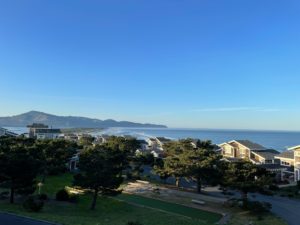
The LSC is the most active committee in The Capes. Each month, the LSC evaluates view restoration requests, approves new construction landscape plans, and assists homeowners with landscape-related questions and issues. The philosophy of the Landscape Committee is that landscaping should be attractive, and owners must acceptably maintain their plants and trees. We encourage all owners to actively manage their landscaping to comply with Section 6.11 of the CC&Rs. Bushes and trees should be pruned or replaced as necessary and not be allowed to grow so that they affect the view of the ocean or bay of other owners.
The volunteers on the LSC strive to help retain ocean and bay views while maintaining the natural coastal beauty of The Capes. Committee volunteers are Gene Mitchell – Chair, Jenny Green – Manager, Louie Bancroft, Cheryl Jones, Mary Lesperance, Cherie Plaisted, and Eric Pleschner.
Hardscaping Makes Meadow More Accessible
The next time you visit The Capes, you will notice a welcome addition to the Meadow. The new concrete path makes getting from the street to the Meadow easier for anyone who is mobility-challenged, and the patio gives us a level surface for picnic tables. A special thank you goes to Eric Pleschner for planning and coordinating the project.
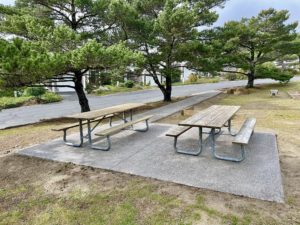
Native Oregonian Comes to The Capes
Quarterly the LSC will feature a community homeowner’s story and how they decided to move to The Capes. Our first homeowner spotlight is Bill Bennett.

Born and raised in what are now the suburbs of Portland, and having lived in Los Angeles and Honolulu with travels abroad, Bill Bennett came home to live at The Capes. He’s among a small handful of original owners and has continuously lived here full time.
During an Oregon visit to see his mom in 1992, Bill stayed at the Seahaven, an inn at the time, just across the north fence of The Capes. Looking out the window from Seahaven, Bill was intrigued to see The Capes in the early stages of development. Calling his partner Noel back home in Honolulu, he enthusiastically said, “Hey, we could live at the beach in Oregon.” The lead-up to moving here weaves an interesting tapestry.
Young Bill left Oregon in 1959, driving his 1953 red Chevy convertible to Los Angeles. With show-business ambitions, he found a job working for the LAMTA (Los Angeles Metropolitan Transit Authority). It started as a modest job, but Bill caught the attention of his supervisors and soon climbed the career ladder. He worked his way up to become Superintendent of Operations Control, being responsible for radio dispatchers, road supervisors, and transit stations. Bill and his team managed over 2000 buses and light rail trains, and his career took him through some historical milestones: the 1984 Olympics, the Watts riots, the annual Tournament of Roses Parade, and the Rose Bowl Games, to name a few.

Bill met his partner, Noel Newhard, in 1970. They lived in Marina del Rey for ten years, then moved to Monterey Hills in 1980, one of LA’s newer suburbs at the time.
In 1989, upon 30 years with LAMTA, Bill retired as part of the “30 and out” program, and Noel also retired. Noel wanted to move to Hawaii, so they relocated to Kailua, Oahu, Hawaii. They immersed themselves in Hawaiian-style living for over four years, surviving hurricane Iniki in 1992. Bill is often still seen wearing one of his prized Hawaiian shirts from his collection.
Returning to Hawaii after visiting with his mom in 1992, Bill asked his sister and brother-in-law to tour The Capes since he wasn’t able to during his time here. They viewed the Kiwanda model on lot 18 and liked it so much that Bill and Noel flew back to see it together. Loving the model, they contacted sales agents, only to receive bad news. Bill said, “Realtors told us all the units on the oceanfront were sold.” Shortly after that disappointment, they were called and notified someone had backed out of their purchase of an oceanfront unit, and they had 24 hours to respond because there was a list of people interested. They quickly called back and said, “Yes, we will take it!”
Bill and Noel flew back to Oregon to finalize their purchase and asked the designers to duplicate the model on lot 18. They learned their home was scheduled to be completed in June 1994. With that in mind, Bill and Noel sold their Kailua home and said goodbye to their close friends there to come here. Bill distinctly remembers the logistics, including using China Airlines to fly the car over and coordinating flying their two cats to the mainland on separate planes – only one cat allowed per plane.
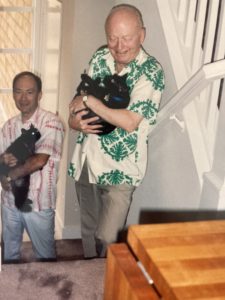
Arriving in Tillamook in June 1994, they discovered that construction was delayed. Bill, Noel, and their two cats stayed at the Tillamook Shilo Inn, or as Noel called it, “the motel in a cow pasture.” They moved into their Capes home on August 10, 1994. At the time of their move, they were one of just three full-time residents. Bill has beautiful photos from their deck of the north staircase, which had over 200 steps descending to the sand. His prized photo albums include great vintage images of The Capes under construction, their first Oregon coast snow, and sunsets over the sea from their home.
Bill remembers events that lead up to the slide. “In 1997, we had just returned home from a trip to the South Pacific, and Bob Wiley met us to say, ‘Guess what happened. Look on the hill.’ There were cracks in the hillside called rifts, and the slide continued. One day, we returned from Tillamook, and the slope slipped 8 feet behind our home.”
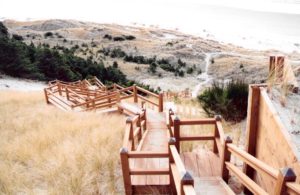
Bill recalls changes in the tides before the slide, “In 1995, the (Netarts) bay opening changed to face a northerly direction. The ocean created a channel to the bay across the front of The Capes. Before the El Nino that year, I think the bay filled in on the southern end, which contributed to driving the channel to the area in front of The Capes. In 1997, the foredune had been eaten away by the tides.”
The historic slide occurred during the winter of 1997-98. In February 1998, 32 homes on the front row were yellow tagged “Dangerous Building, Do Not Occupy” with orders to vacate in four days. Bill says, “As our primary home, we were lucky to buy a home in Netarts to quickly move our entire household into. We lived there over three years, moving back to our home at The Capes in May 2001.”
Back at The Capes, owners of north lots 78 through 69 worked together to stabilize their homes. “We put in stabilization that began construction in spring 2001; our lot was number 72. Paul Schwabe, our neighbor, contacted LRL Construction, owned by Dan Laviolette. Dan provided a bid for the row of homes impacted by the slide, and the cost to shore up the homes was $25,000 per home.” The project got underway, and LRL dug out a long trench along the west side of the northern townhomes. Piling rods were driven into the trench every 3 feet to solid ground. For example, lot 72 has 16 piles behind the structure, extending lengths up to 50 feet into the ground. Every 5 feet, tiebacks were installed with the pile rods to create anchors under each home. The network of rods and rebar was then filled with concrete. The structure was covered over after completion, Bill described.
Based on information from the time, Bill reiterates, “The slide resulted from an El Nino year of high tides, high ocean waves, and storms which undermined the foredune.” Many Tillamook residents were interested in The Capes slide, and Bill gave a speech about the slide and reconstruction projects to a Tillamook women’s group.
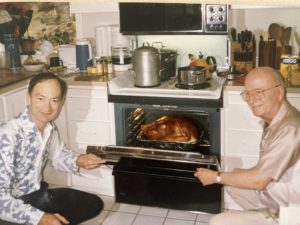
Bill’s life partner Noel passed away in 2006. Noel was a gourmet home chef, “Noel loved our kitchen at The Capes. He would block the kitchen entrance while he worked so that no one could enter. He created some incredible dinners and would create a menu for the week. We would shop in Portland every two weeks at various gourmet stores. Noel had over 300 cookbooks.”
Bill continues to live at The Capes since Noel’s passing. He enjoys spending his time with his cat Ipo, attending TAPA plays and other nearby events, visiting neighbors, and having dinners together with friends.
Bill attributes moving here in 1994 to the beautiful ocean views. He says, “There were few trees at The Capes then, and every property had a gorgeous water view. I’m sad to see many of the ocean views disappear as a result of overgrown trees and hope the community will see how important it is to preserve the original vision of what brought us here.”
View Requests Continue to Increase
Since The Capes community was established in 1990, trees have continued to flourish. Currently, the LSC has 33 open view requests involving 50 lots plus 6 common area tracts.
As trees and shrubs have been allowed to grow unchecked, more owners recognize the need to restore their views. If you have trees growing over the roof of your home or between your home and the home next to you, your landscape is likely impacting the views of your neighbors.
The LSC is helping several North Capes Drive owners restore views that have significantly deteriorated over time. Please be neighborly and trim or remove trees and overgrown shrubs on your property. Replant your yard with low-growing shrubs and dwarf trees. Your neighbors will be thrilled when you restore their view.
If you need to submit a View Restoration Request or would like the LSC to evaluate your property to make sure your landscape isn’t restricting the view of your neighbors, please fill out and submit a Landscape Review Request form.
Top or Replace?
Are you trying to decide whether to cut or top a tree? The Landscape committee recommends that you replace tall overgrown trees with dwarf trees and low-growing shrubs.
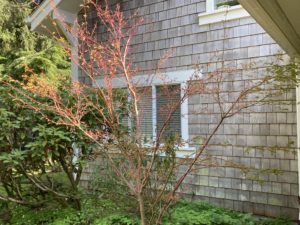
Continuing to top a shore pine year after year is more expensive over the long term and is also really annoying to your neighbors, who must submit a tree request every year for your tree. Instead, plant a beautiful dwarf that you and your neighbors can enjoy.
Start Planning for Spring – The Approved Capes Plant List
If you are not sure what plants are best suited for our coastal climate while maintaining your views, look at the Capes approved plant list. You will find deer-resistant plants and plants that are easier to prune to preserve view corridors above homes, between homes, and across multiple properties.
Wanted: Scotch Broom Stalkers
We need your help to remove Scotch broom weeds from the Capes. Scotch broom is an invasive noxious weed that can produce thousands of seeds, which are viable for up to 80 years.
Do you know how to identify Scotch broom? It is an upright perennial shrub that grows 3-12 feet tall, with slender, sharply angled greenish-brown branches. Yellow flowers make it is easy to find in the Spring. However, when it’s not blooming, you can identify it by its leaves. It has compound leaves with three egg-shaped leaflets 1/2-1 inch long, dark green above, and pale and hairy below.
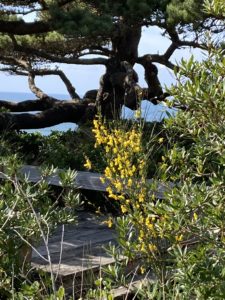
If you see Scotch broom on your property, please remove it by pulling it out or cutting the plant at the base. Then, place the plants in brown paper lawn bags and set them at the curb for pick up.
Spring Clean-Up: May 13 – May 22
The Spring clean-up is a great time to trim overgrown shrubs, top and remove shore pines and take out the pesky Scotch broom weeds.
- The front of Lot #115 on Fall Creek Drive. (East side of the road, just south of 475 Fall Creek Dr.)
- The Meadow (where Capes Drive, Capes Loop, and Capes Point all come together)
- Tract F on Capes Drive (the northernmost point of Capes Drive, right at the point where the road makes a 180° turn)
- Tract N on Promontory Lane (near where the observation platform used to be)
- Near the tennis court
- All woody debris (trees and tree limbs) should be limited to NO LARGER THAN 4 INCHES IN DIAMETER. Anything larger is your responsibility and should not be taken to a clean-up site.
- Please remember that this is for “clean up” and not “clearing.” If you are clearing or significantly thinning a vacant lot, disposal of large amounts of trees will be your responsibility. (Our budget will not handle the disposal of an entire forest. Sorry!) If you are unsure whether what you are planning to remove constitutes a “large amount of trees,” then it probably does…but feel free to contact the office and make sure!
- Take debris to one of the staked sites to be disposed of as part of the Spring Clean-Up. If for some reason, you need Josh to collect debris directly from your lot, it is your responsibility to contact him and let him know. If the debris meets the criteria for items #1 and 2 above (it’s less than 4 inches in diameter and is not a significant number of trees), he will still include it with the HOA disposal items; however, you will be billed for any time/labor charges incurred while collecting the debris from your property. Our contract/arrangement with Josh is for setting up and clearing the 5 collection areas only. Anything above and beyond that requested by a homeowner will need to be done at that homeowner’s expense.